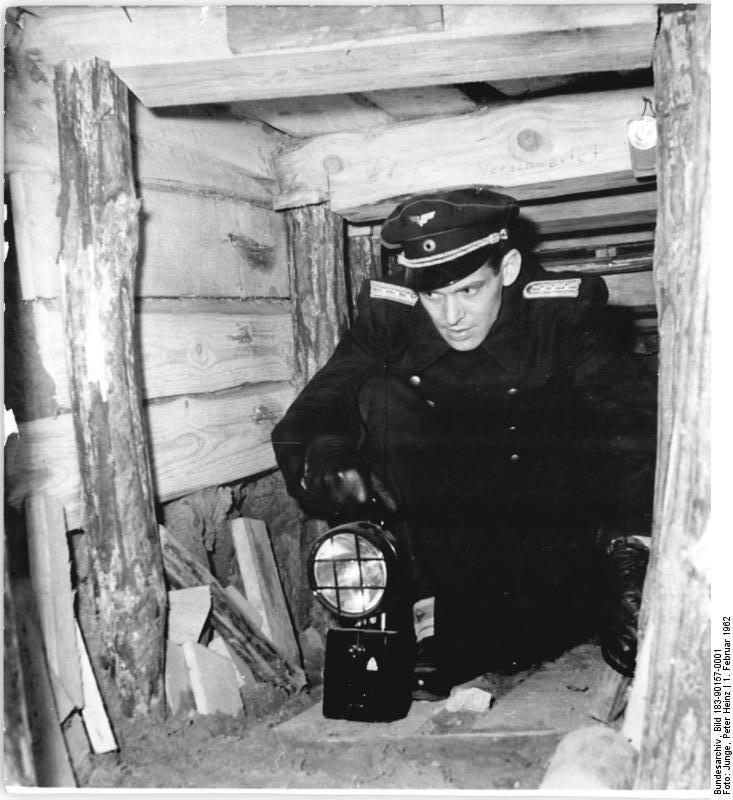Hacking the Death Zone: Ingenious DIY Escapes Across the Berlin Wall
 Aerial view of the Berlin Wall (image via US Military / Wikimedia)
Aerial view of the Berlin Wall (image via US Military / Wikimedia)
This week marks the 25th anniversary of the fall of the Berlin Wall. During the 28 years of the wall’s existence, thousands of citizens of East Berlin attempted to escape from the repressive regime, despite the numerous terrifying ways to die while crossing the wall and its associated “death zone.” Tragically, hundreds were killed in the attempt, but that did not prevent people from devising increasingly ambitious and desperately creative ways to get across. Here’s a roundup of the most unique and ingenious ways people made it across the wall — under, over, through, or around.
Under the Wall
 A member of the state railway inspects the Wollankstraße tunnel (image via Peter Heinz Junge / Wikimedia)
A member of the state railway inspects the Wollankstraße tunnel (image via Peter Heinz Junge / Wikimedia)
In the early days of the wall, tunneling underneath it was the most popular way through. Some tunnels were dug under basements; others through the sewers. A dozen people escaped through Der Seniorentunnel (“the Senior Citizens Tunnel”), which began at a chicken coop and was constructed by a group of elderly citizens led by an 81-year-old man. Another ingenious access point turned out to be in the Pankow Municipal cemetery, where students turned a well-kept gravestone into a hidden tunnel doorway. More than twenty people were able to escape through this tunnel before the Stasi discovered it and sealed it off.
Over the Wall

East German border guard Conrad Schumann leaps into West Berlin over barbed wire on August 15, 1961 (image via Peter Leibing / Wikimedia)
East German border guards had shoot-to-kill orders, so going over the wall meant almost certain death. But many attempts were still made, including one man who successfully climbed over the nine-foot steel-mesh fence using meat hooks. In 1983 Holger Bethke constructed an elaborate zip line to take him over: Pretending to be electricians, he and a friend snuck into an attic with wires and cables hung around their necks, and in the middle of the night they shot an arrow strung with 200 meters of fishing line into West Berlin, where another friend was waiting to secure it to a chimney. They strung a thicker fishing line along the first, fed a steel cable over that, and then careened down the cable on wooden rollers. Another famous airborne escape occurred in 1979: Hans Strelczyk and Gunter Wetzel constructed a homemade hot-air balloon and sailed over the wall with their wives and children — eight people in all. Working together over many months, the escapees pieced together bits of fabric from many different sources (umbrellas, tents, bed linens) to stitch the balloon, welded a basket frame out of found pieces of steel, and built a DIY gas-fired burner out of old propane cylinders. Their ingenious but harrowing escape later inspired the movie Night Crossing.
Through the Wall

An Eastern guard speaks to a Westerner through a broken seam in the wall (image via Sharon Emerson / Wikimedia)
Going through the wall could be sly or brazen. Many people hacked automobiles: enlarging the fuel tank, constructing a fake double floor to conceal a person beneath, even modifying a seat to squeeze someone into. In a much more audacious car hack, in 1963 Heinz Meixner removed the windshield of his tiny convertible and, when the border guards attempted to detain him at the checkpoint, he ducked down, floored the accelerator, and sailed through under the barrier to the West. In a much less thought-out plan, that same year Wolfgang Engels stole a tank and attempted to smash through the wall. He didn’t quite make it and was shot while trying to scramble over the remaining barbed wire, but West Berlin guards came to his aid and brought him to safety. Similar escapes were made with a bulldozer and even a train.
Around the Wall
 Berlin Wall death strip, 1977 (image via George Garrigues / Wikimedia)
Berlin Wall death strip, 1977 (image via George Garrigues / Wikimedia)
If you couldn’t find a way over, under, or through the wall, the only thing left to do was figure out a way around it. In the early days of the wall, many people swam across the Spree River, but in 1965 metal spikes were set into the water just under the surface, providing a very strong deterrent. That left taking the oceanic route out of Germany altogether. In November 1986 Dirk Deckert and Karsten Kluender made it to Denmark by surfing through the frigid ocean for six hours. The following year, an unidentified man paddled from East to West across the Baltic Sea on an air mattress. Much earlier, in 1967, Bernd Böttger, a chemical worker who had been expelled from engineering school, spent a year constructing the first mini-submarine with an internal-combustion motor. Once he completed the sub in 1968, he rode in it for 16 miles — at 3mph — and escaped to Denmark.







Follow us on Twitter to get the latest on the world's hidden wonders.
Like us on Facebook to get the latest on the world's hidden wonders.
Follow us on Twitter Like us on Facebook